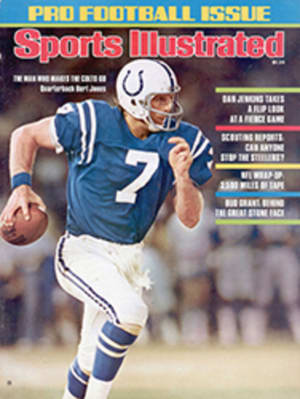
THE DIPSEA DOODLE
Homer Latimer, a runner himself as well as coach of track and cross-country at Gavilan Junior College in Gilroy, Calif., was a winner last week—and a survivor. As he sprinted into the tiny town of Stinson Beach, on the Pacific Ocean a few miles north of San Francisco, his legs were torn and flecked with blood, and a bright crimson stream flowed from a gash on his forehead down his face and neck and onto his chest. The country's second oldest road race, according to its devotees, the 66th Annual Dipsea Race had claimed another winner. The oldest such event, the Boston Marathon (1897), is something you endure. You bask in the glory of running it. The Dipsea you merely survive.
Latimer, who is only 5'3", did not celebrate his survival with a plunge into the ocean, but some of the nearly 2,000 competitors did. This is supposedly why the Dipsea is named what it is, although there are those who feel it should be called the Tipsy or the Dippy because, they say, you have to be one or the other to even set foot on the course. They have a point. "The Dipsea is only 6.8 miles long, from Mill Valley over a mountainous ridge to the ocean at Stinson Beach, but it has one climb of 1,400 feet, another of 700 and hills far steeper, if not longer, than Boston's notorious Heartbreak Hill. It also has precipitous downhill sections where legs and arms and shoulders have been broken. At Boston only hearts are broken.
Yet, as 52-year-old Peter Mattei, who finished 14th, said, "For me the Dipsea is like High Noon. I demand it of myself. I dread it, but I wind up loving it."
That is another thing the Dipsea has: 52-year-old men finishing 14th in a field of 2,000, and 37-year-olds, like Homer Latimer, who win. The secret is handicapping, splitting the huge field into 14 separate groups that start at one-minute intervals. There they all were, at 10 in the morning a couple of Sundays ago, in the town square of Mill Valley, men of 57 and over in one group, women of 34 and over in another, on back to the last starters—the scratch runners, men 16 to 24, who begin 14 minutes after the first group. Only two scratch runners have ever won the Dipsea; when Ron Elijah, who has run three miles on a track in a commendable 13:37, set the course record of 44:49 in 1974, he finished third. The 1973 winner was a 13-year-old girl, who had a 14-minute head start.
Homer Latimer was in Group Five—men 36 to 38—with about 1,300 people starting ahead of him. Latimer led his group from the start, past groves of redwood trees to the foot of a unique Dipsea hill, a narrow wooden flight of 671 steps. The mob ahead of him on the stairway was like an exaggerated version of a department-store escalator two minutes after a $10 sale of $3,000 mink coats had begun. Latimer was ready for the challenge. He had not worn a shirt, in order to be "more slippery," as he put it, and he bent his diminutive body and charged, making some headway upward past hundreds of pumping elbows. But the going was too slow, so he leaped over the railing of the stairway and plowed up the thicketed hillside alongside it, through clumps of blackberry bushes that raked his thighs.
"Pride, pride," he repeated to himself, one of the things he always preaches to his runners. At the top of the steps he ran through the crowd along a lumpy dirt road that climbed past the Flying Y Ranch, where two neurotic-looking dogs stood mute, perhaps not knowing which runner to bark at first. He reached the lip of a downward slope called Windy Gap—and trouble. There were two ways down, a longer, safer one and a shorter, rougher one through private property. He chose the latter. Down he went, past a fearsome coil of barbed wire, to be confronted by a lady who threatened him with a garden hose and screamed, "Get off my land!" She sprayed him. He said, "Thank you, lady," and swerved to avoid another coil of wire. It went that way all day at Windy Gap, the lady threatening and spraying, the runners thanking her, and an ineffectual sheriffs deputy on the road above pointing to the long way and telling the runners, "You go that way or you go to jail."
After Windy Gap, Latimer sprinted along a short stretch of highway, repeating another of his self-psychings, "Legs move faster, legs move faster." He reached the edge of a drop-off called Suicide Hill, perhaps the Dipsea's leading bone-breaker. It falls at a 45-degree angle and is all dirt and pebbles, but because it is wide open, it is a place where the better runners rise onto their toes and sprint down to make up time lost earlier. It is a rather terrifying thing to see, not to mention do, but Latimer raced down, yelling, "Flyer coming!" Those ahead of him, most running cautiously, parted to let him through.
He crossed a road and a stream, headed into Muir Woods and up another hard climb called Dynamite Hill. Bay trees and oaks rose from the dark forest floor. He passed 68-year-old Walter Stack (SI, Dec. 15, 1975), the day's oldest runner, who was competing in his 14th Dipsea. Latimer patted Stack on the rear as he went by and said, "Way to go, oldtimer." Stack muttered something unprintable. Latimer passed other older men, and children, too, many with hands and knees bloodied from falls on Suicide Hill. A voice called out, "You're 24th."
He left the cool woods and entered a hot, long treeless stretch along a ridge the runners call the Hogsback. The heat hit his face as if it came from an open furnace. It was too much for some runners, after the stairs and climbs and the descents, and all along the path they lay crumpled from exhaustion. "Suddenly, I just fell down," said a 48-year-old psychiatrist. Others were walking and, with plenty of room to pass, Latimer lengthened his stride. He was going by someone every few steps now.
"I think I can do it," he thought as he started uphill into another wood, called the Rain Forest. The trees were Douglas firs, and the woods were cool and moist and very still. After less than half a mile the trail rose at a 45-degree angle. This was Cardiac Hill, and for a time the only sound was the panting of the runners. Then someone yelled, "Why is it so quiet in here?" and everyone started talking at once, like chickens. Latimer passed Mattei, said, "Hi, Pete," and then went by 45-year-old Gil Tarin, who had bet Latimer a beer he would not be able to overcome Tarin's three-minute time advantage. Latimer patted Tarin and said, "That was a keg of beer, wasn't it?"
As Latimer topped Cardiac Hill (elevation 1,400 feet), he was in fifth place. He picked up speed again along a narrow, level, shelflike path that rimmed the top of a steep, grassy ravine. Concentration and care were a must here but not easy to achieve. The spectacular California coastline was visible to the north, stretching as far as the eye could see, and to the south the tall buildings of San Francisco glistened in the morning sun. Some runners lost their concentration and their footing, fell and rolled down the ravine, clutching vainly at the grass.
Latimer went on, past Lone Pine Spring, which boasts a spring but no pines, lone or otherwise. The solitary tree is a redwood. He made good time down a gentle grassy stretch before coming to Swoop Hollow, a sudden, steep-sided chute of dirt and pebbles. Down he plunged, "like a bomb," said 48-year-old Don Pickett, who was passed there. Dust rose from Swoop Hollow in an opaque cloud.
"Straight or right?" Latimer called back to Pickett. "Straight," Pickett replied, and as Latimer dropped down a ski-jump-like shortcut, through poison oak and berry vines, a girl hiker who was watching shouted, "You're third."
Latimer entered another rain forest, this one more like a jungle, called Steep Ravine. The trail was a two-foot-wide path, dark and lined with moss and ferns and vines that looked like snakes. Gnarled trees dipped low over the trail, and thick roots threaded their way across it. This was a place for both head-smashing and ankle-wrenching. Ahead of Latimer, 45-year-old Jim Nicholson tripped and hurt his knee. Beyond the ravine, Latimer passed him and moved into second place.
With a mile to go to the finish, Latimer started up Insult Hill, so named by Pickett—"You've been through so much, and now this..."—and overtook the leader, 41-year-old John Finch. "Like he was shot from a gun," Finch said later. Latimer had a big smile on his face, and he vaulted exuberantly over a fence he easily could have ducked under: he flew so high above it that he almost rolled down the embankment on the other side. Then he all but floated through the gently rolling cow pasture that is most of the Dipsea's last mile. He had survived, he had prevailed. What danger was left?
He was full of himself now, but as he started across a highway toward the finish, an automobile suddenly appeared in front of him. Latimer twisted to avoid it and fell heavily onto the road, hitting his head and opening a cut over his eye. The Dipsea had prevailed. But Latimer, blood pouring down, got up and went on to win. His time for the 6.8 miles was 50:03. John Finch was second, Jim Nicholson third and Don Pickett fourth.
In seventh place was the first scratch runner to finish, 26-year-old Bob Bunnell. He had the day's best time, 48:03, but most of the adulation went to Latimer, who stood with the other leaders, smiling and wiping off the blood. Bunnell was not bitter. He said, "There are lots of races I can win; the older runners and the kids deserve their day in court, too." Homer Latimer smiled wanly in agreement. His day had not exactly been spent in court, but it certainly had been a trial.
PHOTO
The huge field, divided into groups according to age and sex, starts at one-minute intervals.
PHOTO
Runners fight for balance as the torturous course plunges down precipitous, rutted Suicide Hill.
PHOTO
In Steep Ravine the route is a tangled jungle.
PHOTO
Sanguine winner Latimer cools with a Coors.

